Let’s have a conversation about the second season of Star Trek: Discovery. Copious spoilers follow ahead if you haven’t already seen the series.
When this show started out, you could feel the tension between long-time fandom and the writers and producers of the new series: the show featured never-before-chronicled tech, never-before-seen uniforms, and bigger and brighter and more modern sets than Star Trek had given us before. And some people…just hated it.
In the past few years, almost all of the major fandoms I belonged to had given me reason to distance myself from them. The loud (but likely very small) faction of Star Wars fandom that insisted that Rey and Finn were created and cast to placate politically correct “social justice warriors” made me weary of that fandom, just as near-identical bleats and complaints drained my enthusiasm for participating in Doctor Who fandom when Jodie Whittaker was cast as the 13th Doctor. Similar complaints, of course, accompanied the casting/character announcements for Star Trek: Discovery, particularly with regard to the characters of Michael Burnham and Philippa Georgiou, two characters I’ve grown as attached to as I have any other in Star Trek history.
I’m still annoyed at the contingent of middle-aged white guys who seem to think that all science fiction media, particularly new offshoots of 40-50+ year old franchises, must be made to cater to them, but I’ve largely tuned them out. And once the signal from that camp is squelched, what remains is the loud, persistent voice of…the canonistas. “This goes against Star Trek canon!” they yelled repeatedly. “Star Trek doesn’t have touchscreen controls on big transparent screens!”
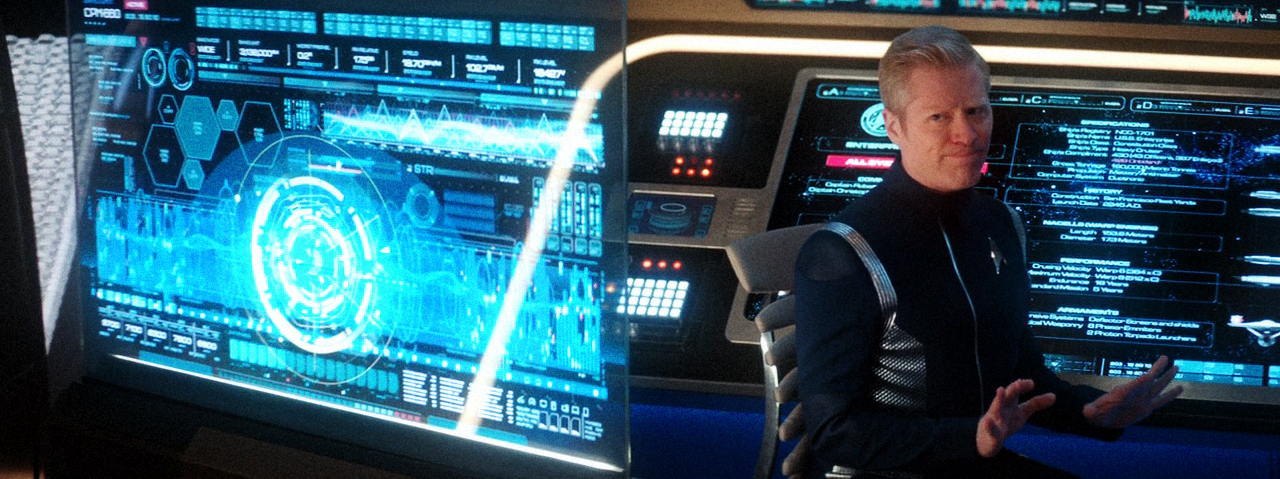
No big glass display screens like that in this universe, guys…
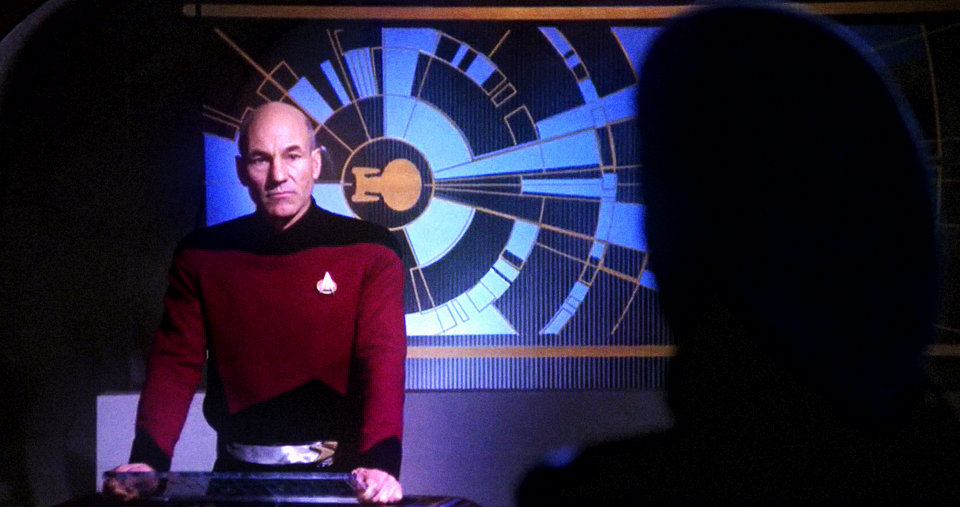
…well, aside from that one…
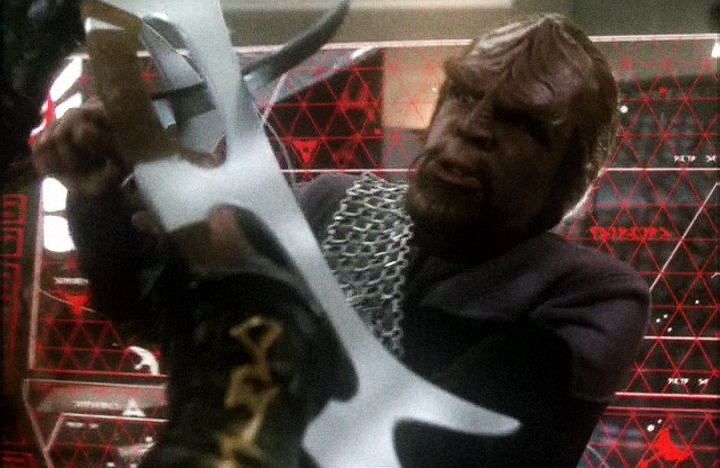
…and this one, moments before Worf got thrown through it,
because of course that would happen to Worf
(That’s funny: the big transparent screens were, contrary to what I originally thought, very real 21st century technology, though I’m sure there was often an assist from CGI; so why wouldn’t the 23rd century have these screens? Especially on an experimental ship serving as a testbed for at least one flavor of new technology.)
And why were screens and control panels really such a hot topic anyway? The ubiquitous touchscreens of the 24th century shows had to start somewhere. And in any case, the 24th century shows – TNG, DS9, Voyager – obviously have no big glass display monitors and no real touchscreens, they have other things standing in for those. DS9 and Voyager, in rapid succession, set world records for the number of live video monitors on a television set, though these were integrated into the sets to disguise the fact that they were, well, 20th century computer monitors. If the cameras got close enough, the telltale curvature of the screens gave away what the “touchscreens” mounted in the walls were really made of.
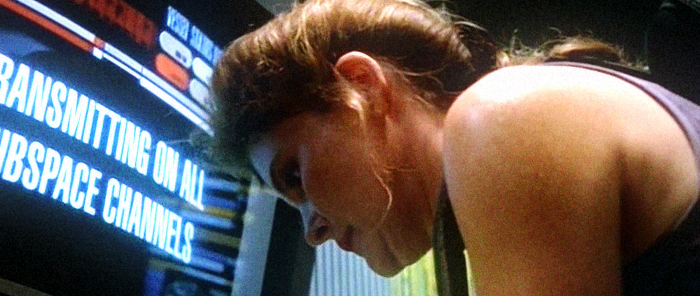
So they restart production on radiation-spitting CRT monitors in the future?
So…were we to infer that these were 15″ CRTs, or that they were 15″ CRTs standing in for something much more technologically advanced? And if we can make that leap with 15″ CRTs in a show from the 1990s, can we not make the same inference when it comes to the original Enterprise sets from the 1960s? Or are those supposed to be boxes of blinky lightbulbs? When did we stop suspending disbelief for the sake of complaining?
As for uniforms: different divisions, in different duty environments, sport different uniforms. Starfleet may not have different branches of service like the modern-day Armed Forces, but from the first moment that Captain Kirk started sporting that disquietingly tight wraparound shirt that was a slightly different color from his standard uniform, it was obvious that there were multiple Starfleet uniform options.

Starfleet’s got the blues. So bad. Starfleet would never make every uniform mostly one color.

Oh.
But those are all just the “technical” continuity complaints. What I worry about is that this loud, persistent, frequently obnoxious chorus might’ve had an effect on the show’s creative direction.
So here’s what I want to know from the writers of Star Trek: Discovery. Did all of this complaining over various flavors of minutae – ship design, uniforms, control panels, display technology, etc. – divert the flow of Discovery’s storytelling?
I’m a fan of new stories. When it comes to “prequelizing” existing stories, I like new stories that reframe the old – Rogue One has been my go-to example of doing this right in recent years, though it’s nearly eclipsed by Lethe, my favorite episode from Discovery’s first season, which rewrote the DNA of Spock’s relationship with his father, Sarek, throughout the remainder of the existing body of Star Trek storytelling. (No mean feat given that Spock appeared nowhere in Discovery’s first season.) Why does Sarek come down so hard on Kirk about having left Spock’s body on the Genesis planet? Because Sarek already lost one child (two if you count Sybok, who, to my amazement, wasn’t mentioned anywhere during Discovery’s “Spock season”), and he wasn’t about to lose the last one. An elegant story putting Sarek’s relationship with Michael Burnham in perspective, Lethe changed what we thought we knew about the Sarek-Spock dynamic: Sarek didn’t disapprove of Spock enlisting in Starfleet because he didn’t approve of Starfleet or humans, he disapproved because he had made a painful choice between Spock and Michael for a coveted slot at the Vulcan Science Academy, and had chosen in favor of Spock, rather than Michael…and then watched as Spock passed up the opportunity that could/should have been Michael’s. Lethe is some really good prequelizing.
Discovery’s second season, however, is a sprawling, interconnected time travel epic, one which doesn’t tell us why certain things have been happening all season long until the very end. (And it still doesn’t explain some things, such as the catastrophic failure that leaves the Enterprise out of the picture early in the season; the culprit here may be an abrupt change of showrunners decreed by the studio after some disturbing reports of not just mismanagement, but mistreatment, of the creative staff by the producers left in charge after the departure of Bryan Singer.) Along the way, we’re glibly told about – to use just one example – removal of holographic communications systems from the Enterprise (Captain Pike prefers to communicate via viewscreens). This culminates in a season finale that not only sends Discovery and what some fans claimed was a shipload of anachronistic technology nearly a millennium in to the future, but swears the Enterprise characters to secrecy on the Discovery‘s very existence and that of its crew, thus resolving the frequent first season fan gripe that Spock never mentions his adopted sister, Michael Burnham, ever again. (Wait, I’ve got this one: it’s because all of the previous series were filmed years or decades before Discovery was conceived.) The official @StarTrekWriters account on Twitter has gone public with the writers’ intention: the next season, and Discovery, stays in the 32nd century.
Was this story told because this was the story originally devised for Discovery’s second season, or was this story told to explain away every complaint and jettison the 23rd century setting? How much was this season shaped by fandom overreactions to the fact that you can’t make a show for a general audience in the 21st century with sets and uniforms that look like the 1960s version of the future? Was this what the writers had in mind from that moment at the end of season one in which the Enterprise appears? Or was everything, from Pike ordering the Enterprise’s holographic communicators dismantled to sending Discovery into the far future, there to get fandom off the writers’ backs?
If the answer is the latter, then the relationship between the show’s writers’ room (and its Twitter account) and fandom needs to be reassessed, and urgently so. I’m of the opinion that the best model for the makers of a current series interacting with fandom online was set in the 1990s by J. Michael Straczynski, who used the nascent internet to explain creative and production decisions involved in making Babylon 5 in real time, but wasn’t afraid to point out that this was less of a two-way conversation and more of a controlled, official leak of production information. He was not there to have stories pitched at him, or to take flack from fans who just didn’t “get it”. When that show’s long-boiling Shadow War story arc culminated in a conversation rather than a conflagration, that decision was explained, and anyone who still didn’t get it was often told, in no uncertain terms, that their expectations of an all out pew-pew special effects war was more their problem than the showruner’s. Straczynski had already mapped out the story he planned to tell; fandom was not going to alter its course. He was there to promote the show, offer a little bit of real-time education into how the sausage was made, and leave it at that.
On the surface, this seems to be how the Trek writers’ room account is used, but this being 2019 rather than 1994, the sheer volume of incoming fire on that account has to be deafening.
I’ll acknowledge that there are probably very few writers of TV and film who didn’t get into the business after being inspired by someone else’s writing; some of these writers likely started out as fans in their own right. In fact, there once was a time when the 1990s Star Trek series had a more-or-less-open script submission policy, so long as those submissions were accompanied by a legal release form constituting a contract absolving the studio from any harm, implied or otherwise, if a story similar to your pitch got made because someone else got to the idea first. Those of us who were teenagers when TNG premiered were regaled with Starlog and Cinefantastique’s retellings of the Cinderella story of one Ronald D. Moore, who got a script in the door, was later hired as a staff writer and story editor, and – several years after working on multiple Trek spinoffs – went on to reimagine a little thing called Battlestar Galactica. You might have heard of him.
If you were that age when all of that went down, there was no way you didn’t want to be the next Ronald D. Moore. Like many folks, I took my shot. It turns out that I wasn’t much better at attempting to write a TV script than I was at attempting to write longform prose, but you know, I still treasure my rejection letter to this day. It’s kind of like a pre-press rookie card that never had a reason to go to the printers: proof that I stood at the plate and took a swing at it. And missed. (And yes, you can read it for yourself and weep.)

Maybe it was the whole thing about CGI space hippos?
But I can tell you with certainty that neither myself, nor Ronald D. Moore, nor anyone else who ever tried to break into TV storytelling, did so for the express purpose of having stories dictated to us by the faceless and frequently clueless “committee” that is the internet. When did fandom graduate from fanfic and fan films to trying to tell professional writers exactly what they wanted to see – or, worse yet, what stories couldn’t be told?
I’m not making any claims that Star Trek: Discovery is unassailably perfect, but I had hoped that maybe we could trust the writers to tell their story and explain how Discovery and her crew fit in to the stories we already knew, which it seemed that season 2 was doing nicely…until the sudden slingshot into the future made it clear that the entire series will effectively be re-piloted in 2020.
Will this make anyone happy? Who knows. There’s a snarky saying – and generally, I hate internet snark, but in this case it’s so true – that nobody hates Star Trek like Star Trek fans. (Feel free to also substitute Doctor Who, Star Wars, or whatever fantastical media franchise fits.) What bothers me is the nagging feeling that fandom threw so many rocks in the narrative river that it became necessary to divert its flow. I’m pretty canon-conscious myself, but I enjoy the creative exercise of making things fit as they are laid out before us, rather than bitching endlessly about how they don’t. I wish I could shake that feeling, because the narrative erasure of Discovery and her crew from the “official” timeline sure feels like fandom may have had undue influence here, which requires the question: who are showrunners supposed to be making these shows for – as wide an audience as possible, or hardcore fandom only?


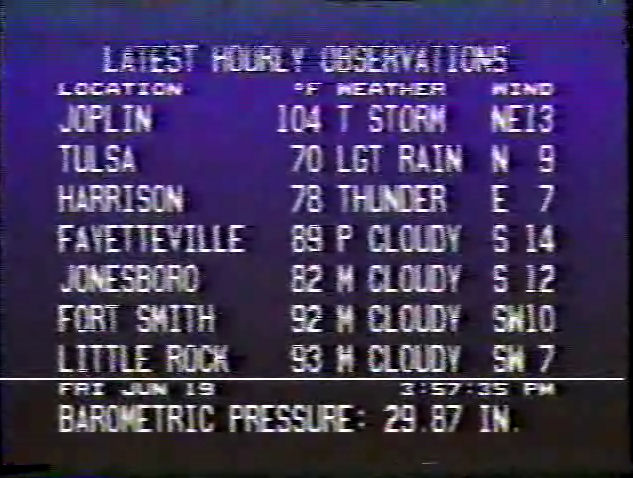
+ There are no comments
Add yours